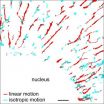LOS ANGELES, CA, March 08, 2011 (Press-News.org) semYOU, the free app computing system that makes using software and the Internet much easier, will be available starting today at www.semyou.com. Local software installation, purchased software and tedious updates are finally a thing of the past. The innovative app computing system from the startup firm semYOU provides the most important functions, including office, entertainment and communication functions, through free cloud computing applications. Every application is just a click away.
semYOU app computing presents a brand-new approach to using software: the large number of free power applications allows all tasks to be completed easily over the Internet through cloud computing - without installation, from any computer in the world. Personal documents, files, music and photos, task lists or notes are available anytime, anywhere. Another advantage: the personalized semYOU desktop looks the same regardless of where login takes place - in the office, at home or at the Internet cafe.
This makes the semYOU app computing system very different from other cloud computing providers, who typically offer only a simple online hard drive. At the core of this new Internet-based operating system lies the free and convenient use of many different applications for home and business customers. semYOU is not only a web desktop, but thanks to its new app store, it's also a free tool suite with more than 25 different ad-free applications that make buying software unnecessary. Over the next several weeks, more semYOU apps will be released, including an Enterprise Suite with special applications for businesses. Because semYOU is not based on HTML5 but on Microsoft's Silverlight technology, for the first time web applications can offer functions that were previously reserved only for rich client applications.
"With semYOU, the cloud finally gets a face," explains Volker Jahns, CEO of semYOU LLC. "We're showing how the Internet will look tomorrow, today: a single standard web desktop with free software on demand through applications and central, secure storage of all personal data - accessible from any computer in the world."
August 2010 marked the release of the first beta version of semYOU. Since then, the app computing system has been continuously optimized with the help of users. semYOU Version 1.0, released today, consists of a web desktop and an affiliated app store. After login, all applications can be run in three different ways: via the semYOU web desktop, directly via the app store or through a local link on desktop PCs, notebooks or netbooks.
For more information about semYOU, visit www.semyou.com.
About semYOU
Entrepreneur Volker Jahns founded semYOU in 2010 as a startup company in L.A. Its core business is developing semYOU, the first semantic online operating system that offers users a completely new web experience.
Press contact
For more information, graphics, photos or interviews, please contact:
semYOU LLC.
13101 Washington Blvd.,
Los Angeles CA 90066
press@semyou.com
www.semyou.com
Tomorrow's Internet Starts Today: semYOU, the Free App Computing System
App computing: Startup firm semYOU presents free applications for simple cloud computing. It's time to semYOU.
2011-03-08
ELSE PRESS RELEASES FROM THIS DATE:
The connection between a cell's cytoskeleton and its surface receptors
2011-03-07
WASHINGTON, D.C. (March 6, 2011) -- New findings from researchers at Harvard Medical School in Boston and the Hospital for Sick Children in Toronto may shed light on the mechanisms that regulate the organization of receptors on the cell surface, a critical aspect of cell signaling not well understood at this time.
The group reports on their use of the macrophage protein CD36, a clustering-responsive class B scavenger receptor, as a model for studying the processes governing receptor clustering and organization. The protein is involved in a number of cellular and physiological ...
Scientists probe the role of motor protein in hearing loss
2011-03-07
WASHINGTON, D.C. (March 6, 2011) -- From grinding heavy metal to soothing ocean waves, the sounds we hear are all perceptible thanks to the vibrations felt by tiny molecular motors in the hair cells of the inner ear. Researchers at the University of Pennsylvania School of Medicine have now identified the mechanism by which a single amino acid change can disrupt the normal functioning of one of the critical components of that physiology -- a molecular motor protein called myo1c, which resides in the cochlea of the inner ear.
The mutation (called R156W), was first identified ...
Avoid risking children's health during home energy retrofits, renovations, experts urge
2011-03-07
Home energy retrofits tackle climate change and when done right they should make homes healthier, while aiding families struggling with utility bills.
Without adequate training and precaution, however, renovators, energy retrofitters and do-it-yourselfers who disturb lead-based paint, asbestos insulation and other toxic materials in older buildings put the health of all -- especially children -- living there at risk of serious health impacts.
Lead exposure can potentially lead to lowered intelligence and worse; asbestos exposure can potentially lead to debilitating ...
New role for an old molecule: protecting the brain from epileptic seizures
2011-03-07
PROVIDENCE, R.I. [Brown University] — For years brain scientists have puzzled over the shadowy role played by the molecule putrescine, which always seems to be present in the brain following an epileptic seizure, but without a clear indication whether it was there to exacerbate brain damage that follows a seizure or protect the brain from it. A new Brown University study unmasks the molecule as squarely on the side of good: It seems to protect against seizures hours later.
Putrescine is one in a family of molecules called "polyamines" that are present throughout the body ...
Rehabilitation within a day of knee replacement pays off
2011-03-07
Starting rehabilitation sooner following knee arthroplasty surgery could pay dividends - for both patients and hospitals. Commencing physical therapy within 24 hours of surgery can improve pain, range of joint motion and muscle strength as well as cut hospital stays, according to new research in the journal Clinical Rehabilitation, published by SAGE.
Mindful of the trend towards discharging patients from hospital more rapidly after surgery in recent years, physical therapy and public health researchers from Almeria, Malaga and Granada in Spain set out to investigate whether ...
Leicester leads on heart attack genetic link discovery
2011-03-07
The largest-ever study of its type into coronary heart disease, involving scientists from the University of Leicester, has uncovered 13 new genes that increase risk of heart attacks.
Professor Nilesh Samani, British Heart Foundation Professor of Cardiology at the University of Leicester, based at Glenfield Hospital, who co-led the international research programme, called CARDIoGRAM, said most of genes identified were not previously known to be involved in the development of coronary heart disease, opening of the possibility of developing new treatments for this common ...
New gene regions identified that predispose people to heart attacks, Stanford scientists say
2011-03-07
STANFORD, Calif. — Thirteen new gene regions have been convincingly linked to coronary atherosclerosis in a massive, new, international genetics study involving investigators from the Stanford University School of Medicine.
The results of the study, to be published online March 6 in Nature Genetics, provide 13 vital new clues on the etiology of this disease, the most common cause of death worldwide. The study doubles the number of gene regions previously known to predispose people to this condition. Coronary atherosclerosis is the process by which plaque builds up in ...
Gene responsible for severe osteoporosis disorder discovered
2011-03-07
Scientists have identified a single mutated gene that causes Hajdu-Cheney syndrome, a disorder of the bones causing progressive bone loss and osteoporosis (fragile bones). The study, published in Nature Genetics today, gives vital insight into possible causes of osteoporosis and highlights the gene as a potential target for treating the condition.
There are only 50 reported cases of Hajdu-Cheney syndrome (HCS), of which severe osteoporosis is a main feature. Osteoporosis is a condition leading to reduction in bone strength and susceptibility to fractures. It is the most ...
New report helps inform decisions about how science should be funded
2011-03-07
Clinical research has greater societal impact over a 15-20 year timescale, while basic research has greater academic impact, according to a new study from RAND Europe and the Health Economics Research Group (HERG) at Brunel University.
Project Retrosight was a multinational, four-year study that investigated the translation of basic biomedical and clinical cardiovascular and stroke research, and its impact on future work, policy, products and healthcare. The study was based on a rich source of material taken from 29 carefully selected case studies of grants for research ...
Landmark study links 13 new genes to heart disease
2011-03-07
OTTAWA – March 6, 2011 – Insight into the complex biological mechanisms that cause heart disease has taken a major step forward with the discovery of 13 new genes that increase the risk of coronary artery disease (CAD). The influence of the majority of the new genes is independent of other established risk factors, suggesting new, unsuspected causes of CAD. The discovery more than doubles the number of genes known to affect the progression of heart disease.
The research also verified the association of 10 previously identified genes to the population at large, meaning ...
LAST 30 PRESS RELEASES:
Tracing the quick synthesis of an industrially important catalyst
New software sheds light on cancer’s hidden genetic networks
UT Health San Antonio awarded $3 million in CPRIT grants to bolster cancer research and prevention efforts in South Texas
Third symposium spotlights global challenge of new contaminants in China’s fight against pollution
From straw to soil harmony: International team reveals how biochar supercharges carbon-smart farming
Myeloma: How AI is redrawing the map of cancer care
Manhattan E. Charurat, Ph.D., MHS invested as the Homer and Martha Gudelsky Distinguished Professor in Medicine at the University of Maryland School of Medicine
Insilico Medicine’s Pharma.AI Q4 Winter Launch Recap: Revolutionizing drug discovery with cutting-edge AI innovations, accelerating the path to pharmaceutical superintelligence
Nanoplastics have diet-dependent impacts on digestive system health
Brain neuron death occurs throughout life and increases with age, a natural human protein drug may halt neuron death in Alzheimer’s disease
SPIE and CLP announce the recipients of the 2025 Advanced Photonics Young Innovator Award
Lessons from the Caldor Fire’s Christmas Valley ‘Miracle’
Ant societies rose by trading individual protection for collective power
Research reveals how ancient viral DNA shapes early embryonic development
A molecular gatekeeper that controls protein synthesis
New ‘cloaking device’ concept to shield sensitive tech from magnetic fields
Researchers show impact of mountain building and climate change on alpine biodiversity
Study models the transition from Neanderthals to modern humans in Europe
University of Phoenix College of Doctoral Studies releases white paper on AI-driven skilling to reduce burnout and restore worker autonomy
AIs fail at the game of visual “telephone”
The levers for a sustainable food system
Potential changes in US homelessness by ending federal support for housing first programs
Vulnerability of large language models to prompt injection when providing medical advice
Researchers develop new system for high-energy-density, long-life, multi-electron transfer bromine-based flow batteries
Ending federal support for housing first programs could increase U.S. homelessness by 5% in one year, new JAMA study finds
New research uncovers molecular ‘safety switch’ shielding cancers from immune attack
Bacteria resisting viral infection can still sink carbon to ocean floor
Younger biological age may increase depression risk in older women during COVID-19
Bharat Innovates 2026 National Basecamp Showcases India’s Most Promising Deep-Tech Ventures
Here’s what determines whether your income level rises or falls
[Press-News.org] Tomorrow's Internet Starts Today: semYOU, the Free App Computing SystemApp computing: Startup firm semYOU presents free applications for simple cloud computing. It's time to semYOU.


